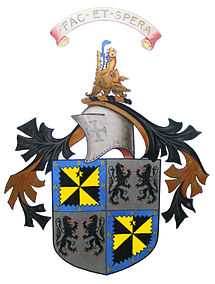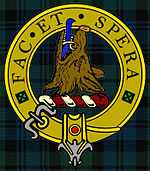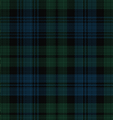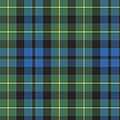Carter-Campbell of Possil
| Carter-Campbell of Possil | |||||||||
|---|---|---|---|---|---|---|---|---|---|
| Campbell of Possil Crest Badge | |||||||||
| | |  | ||||||||
| | | Motto: Fac et spera (Latin = Do and Hope) | ||||||||
|
| |
Battle cry: Cruachan![1] | ||||||||
| Profile | |||||||||
| | | Districts | bgcolor="#efefef" | Castle Martin,[2][3][4] County Kildare.[5][6] Achnacroish[7] and Ardrishaig, Argyllshire. Possil, Lanarkshire.[8] Craigenputtock Dumfriesshire.[9] | ||||||
| | | Plant badges | bgcolor="#efefef" | Shamrock[10] and Bog Myrtle [11] | ||||||
| | | Animal Mascots | bgcolor="#efefef" | Rampant Combatant Lions,[12] Talbot and Wild Boar.[13] | ||||||
| | | Pipe music | bgcolor="#efefef" | "The Campbells are Coming"[14] | ||||||
| | | Gaelic name | bgcolor="#efefef" | Cairtear-Cambeulach[15][16] | ||||||
| Armorial Bearings | ||||||||||
|---|---|---|---|---|---|---|---|---|---|---|
|
| |
 Colin Duncan Carter-Campbell of Possil (10th of Possil) | |||||||||
|
| |
Gaelic Name | bgcolor="#efefef" | Cailean Donncath (Χ dar Possele)[17] | |||||||
| | | Seat | bgcolor="#efefef" | Craigenputtock[18] | |||||||
| | | Historic seat | bgcolor="#efefef" | Possil[19] | |||||||
|
| |
Last Head | bgcolor="#efefef" | Lt. Col. Duncan Maclachlan Carter-Campbell of Possil OBE[20] | |||||||
| Carter of Castle Martin Crest Badge | |||||||||
|---|---|---|---|---|---|---|---|---|---|
| | |  | ||||||||
| | | Motto: Victrix Patientia Duris(Latin = Patience is victorious in hardship) | ||||||||
<noinclude>
| Septs of Carter-Campbell of Possil |
|---|
| Shaen-Carter,[citation needed] Thain-Davidson,[citation needed] Maclachlan[citation needed] |
| Septs of Clan Campbell |
|---|
| Arthur, MacArtair, MacArthur, MacCarter.[21] Bannatyne, Ballantyne, Blanton.[21] Burnes, Burness, Burnett, Burns.[21] Caddell, Cadell, Calder, Cattell.[21] Connochie, Conochie, MacConachie, MacConchie, MacConnechy, MacConochie.[21] Denoon, Denune.[21] Gibbon, Gibson, MacGibbon, MacGubbin.[21] Harres, Harris, Hawes, Haws, Hawson.[21] Hastings.[21] Isaac, Isaacs, Kissack, Kissock, MacIsaac, MacKessack, MacKessock, MacKissock.[21] Iverson, Macever, Macgure, MacIver, MacIvor, Macure, Orr, Ure.[21] Kellar, Keller, Maceller, MacKellar.[21] Lorne.[21] Louden, Loudon, Loudoun, Lowden, Lowdon.[21] MacColm, MacColmbe, MacLaws, MacLehose, MacTause, MacTavish, MacThomas, Riddell, Taweson, Tawesson, Thomas, Thomason, Thompson, Thomson.[21] MacDermid, MacDermott, MacDiarmid.[21] MacElvie, MacKelvie.[21] MacGlasrich.[21] MacKerlie.[21] MacNichol.[21] MacNocaird.[21] MacOran.[21] Macowen.[21] MacPhedran,[21] MacPhederain,[22] Paterson.[22] MacPhun.[21] Moore, Muir.[21] Ochiltree.[21] Pinkerton.[21] Tanner, Tonner, Torrie, Torry.[21] |
| Clan Branches |
|---|
| Campbell of Argyll (chiefs) Campbell of Strachur (senior cadets) Campbell of Breadalbane Campbell of Cawdor Campbell of Loudoun, Carter-Campbell of Possil See also: Campbell baronets |
| Allied Clans |
|---|
| Clan Bruce Clan Grant Clan Drummond Clan Leslie Clan Malcolm Clan Scott Clan Forbes Clan Stewart of Balquhidder Clan Menzies Clan MacInnes Clan MacEwen Clan MacCallum Clan Maclachlan |
| Rival Clans |
|---|
| Clan MacDougall Clan Donald Clan Arthur Clan Lamont Clan MacGregor Clan MacLaren Clan Maclean Clan Mackinnon Clan MacAlister Clan MacLea Clan MacMillan Clan Farquharson Clan Ogilvy Clan Sinclair |
<noinclude>
 |
The Campbells are Coming!
For pipes and drums.
|
| Problems playing this file? See media help. | |
Carter-Campbell of Possil or Campbell of Possil is a branch of the Scottish clan Clan Campbell.[23]
History
Campbell of Possil
This family is descended from Sir Colin Campbell of Glenorchy, Earls of Breadalbane[24] (see that title). Sir Colin was the second son of Duncan Campbell, 1st Lord Campbell who was Uncle and Guardian of Colin 1st Earl of Argyll in 1453 (see Campbell Dukes of Argyll[25]). See Burke's Landed Gentry of Great Britain 19th edition volume I, The Kingdom of Scotland. See also Campbell Barons Colgrain and Campbell of Inverneill in this volume.
The family is a branch of the Campbells of Kinloch, an off shoot of the Campbells of Murthlie, who sprang from a younger son of Campbell of Lawers (see Burke's Peerage and Gentry).
Carter of Castle Martin
This family: Boyle Carter[26][27][28][29] and Shaen Carter[30][31][32] are descended from Carter of Shaen Manor, County Mayo[33] and the Carters of Robertstown,[29] County Meath[34][35] (see Burke's Irish Landed Gentry).
Motto
Fac et Spera
Translated from its Latin as "Do and Hope"
Notable bearers


Motto: Patience is victorious in hardship.

Motto: Do and Hope.
Notable members of the Clan and bearers of this coat of arms and the Armorial Bearings shown below:
- Colonel Thomas Tupper Carter-Campbell of Possil, Lanarkshire.
- Admiral John Carter R.N.
- The Hon. John Butler
- Humphrey, 1st Earl of Lanesborough
- Major General George Campbell C.B. of Inverneill, Argyllshire.
- John Campbell of Possil Esq.[36] and of Torosay Castle[37] (Duart House) the Achnacroish Estate,[38] Isle of Mull (1816–1885) Deputy Lieutenant and Justice of the Peace, an officer of the 7th Dragoon Guards.
.[39]
- Colonel Alexander Campbell of Possil[40][41] (painted by Sir Henry Raeburn[42]).[43]
- Major General George Tupper Campbell Carter-Campbell[44][45] C.B., D.S.O.[46] (George Carter-Campbell[47]).[48] Cameronians (Scottish Rifles).
- Lt. Colonel Duncan Maclachlan Carter-Campbell of Possil O.B.E. Cameronians (Scottish Rifles).
- Rt. Hon. Thomas Carter, Member of Parliament Secretary of State and Master of the Rolls[49][50][51] (painted by Charles Jervas).
- Mrs Alexander Campbell of Possil.[52][53] (painted by Sir Henry Raeburn[54]). Née Harriet Maclachan[55] of Castle Lachlan,[56] Argyll[57] (see Clan Maclachlan).[58][59]
- Lt. General Sir James Campbell of Inverneill.
- Major General Sir Archibald Campbell K.B. of Inverneill, Argyllshire painted by George Romney.[60]
- Duncan Campbell of Inverneill. Painted by Sir David Wilkie.[61]
- Major General John Tupper His Majesty's Marine Forces.
- Baron Campbell of Colgrain and Camis Eskan, Helensburgh, Dunbartonshire painted by Sir Henry Raeburn[62] (see Baron Colgrain).
Union of the two Families


This was the union of two land owning families,[63] the Carters of the Castle Martin estate, County Kildare, Ireland and the Campbells of the Possil estate, Lanarkshire, Scotland. Colonel Thomas Tupper Carter (Lord Lieutenant and Justice of the Peace, Argyllshire and grandson of the Rt. Hon Thomas Carter Master of the Rolls and son of Admiral John Carter R.N.) married Miss Emily Georgina Campbell of Possil IV (granddaughter[64] of Colonel Alexander Campbell of Possil[65][66]) in 1864. Their matrimonal home was the Fascadale estate,[67] Ardrishaig, Argyllshire. Miss Emily Georgina Campbell of Possil IV who owned the Possil estate also wished to retain her surname and Colonel Thomas Tupper Carter[68] therefore added the name of Campbell to his surname in 1864.[69]
Lamont-Campbell of Possil
Tartans
 1420 - 1556 |
 1475 |
 1475 - 1616 |
 1525 |
|---|---|---|---|
 1600 - 1776 |
 1750 - 1772 |
 1780 -1809 |
 1780 - 1892 (Lamont-Campbell) |
 1780 - 1952 (Carter-Campbell) |
 1800 - 186 |
 1946 |
 1960 - 1966 |
The tartans attributed to the family:
-

Ancient Campbell Tartan
-

Campbell of Breadalbane Tartan
-

Irish Saffron
-

The tartan of County Kildare
Clan Campbell of Possil Family Mausoleum

The family mausoleum is situated in the Parkland[70] within the grounds of Torosay Castle.[71] Those family members buried there include:
<ref name="Works: "Virginibus puerisque" and other papers. Dr. Jekyll and Mr. Hyde.">
Robert Louis Stevenson. "Works: "Virginibus puerisque" and other papers. Dr. Jekyll and Mr. Hyde". Volume 2 of Works (Collier).
</ref>
- Mrs Alexander Campbell of Possil[75] Née Harriet Maclachan[citation needed] of Castle Lachlan,[76] Argyll[77] (see Clan Maclachlan painted by Sir Henry Raeburn[78]).[79]
- John Campbell of Possil Esq.[80] and of Torosay Castle[81] (Duart House[82]) The Achnacroish Estate,[83] Isle of Mull[84] and his three wives: Elizabeth Campbell of Ballimore,[85] Helen Bogle Campbell of Colgrain[86] and Elizabeth[87] daughter of Donald Horne W.S.[88]
Torosay Castle, Isle of Mull

John Campbell of Possil[89] (nicknamed "The Dragoon")[90] who was the son of Colonel Alexander Campbell of Possil,[91][92] employed architect, David Bryce,[93] and built the castle on the Isle of Mull[94] on the Torosay estate[95][96] after acquiring it from his father[97][98] in 1858.[99]
The armorial bearings of the Campbells of Possil and the Crest, as shown above, are carved in stone[100] and displayed on each elevation of the castle walls.[100]

References

- ↑ Keltie, John. "Campbell of Argyll". celticbug.
- ↑ Burke, Sir Bernard (1852). "A genealogical and heraldic dictionary of the landed gentry of Great Britain & Ireland for 1852: comprising particulars of upwards of 100,000 individuals". Volume 1 (Colburn and Co.).
- ↑ Burke, Bernard; Townsend, Peter (1965). "Burke's genealogical and heraldic history of the landed gentry". Volume 3 (Burke's Peerage).
- ↑ Burke, Sir Bernard (1853). Index to Burke's Dictionary of the landed gentry of Great Britain & Ireland: comprising all the names (upwards of 100,000) mentioned in the work. Hurst and Blackett.
- ↑ Kavanagh, Michael V. (1976). A contribution towards a bibliography of the history of County Kildare in printed books. Kildare County Council.
- ↑ Burke, Sir Bernard (1852). "A Genealogical and Heraldic Dictionary of the Landed Gentry of Great Britain & Ireland for 1852: Comprising Particulars of Upwards of 100,000 Individuals". Volume 3 (Colburn and Co.).
- ↑ Great Britain. Parliament. House of Commons (1851). "Parliamentary papers,". Volume 26 (HMSO).
- ↑ Burke, Sir Bernard (1937). "Genealogical and heraldic history of the landed gentry: founded by the late Sir Bernard Burke". Volume 3 (Shaw).
- ↑ TheGlasgowStory. "Possil House". Sp Coll Dougan Add. 73 TheGlasgowStory. Glasgow University Library, Special Collections, Dougan Collection.
- ↑ McCalmont, Rose Elizabeth; Barret, C. R. B. (1915). Memoirs of the Binghams. Spottiswoode.
- ↑ A History of Clan Campbell Vol.1, p.294. by Alastair Campbell of Airds, Edinburgh University Press. ISBN 1-902930-17-7.
- ↑ Stevenson, Robert Louis (1897). "Works". Volume 13 (C. Scribner's).
- ↑ Beauclerk Dewar, Peter. Burke's landed gentry of Great Britain. Burkes Peerage & Gentry Llc; 19th edition (August 2001) ISBN 0-9711966-0-5. pp. 183,184.
- ↑ Seaver, Jesse Montgomery (1971). Campbell family history. American Genealogical Research Institute.
- ↑ Oxford Companion to Scottish History, p.64 – 66. Edited by Michael Lynch, Oxford University Press. ISBN 978-0-19-923482-0.
- ↑ "Babylon Gaelic Translate". Cairtear. Babylon.com LTD.
- ↑ "Burke's family index". Burke's series (Burke's Peerage). 1976.
- ↑ "Dumfries and Galloway Council Public Enquiry Statement" (pdf). Public Inquiry Statement. Dumgal, Carlyle Craigenputtock Circle. 2007-10-18.
- ↑ Smith, John Guthrie; Mitchell, John Oswald (1878). "The old country houses of the old Glasgow gentry". LXXXIII. Possil. Glasgow Digital Library.
- ↑ "Burke's Peerage & Baronetage 107th Edition, Burke's Landed Gentry 19th Edition". Carter-Campbell of Possil. Burke's Peerage & Gentry.
- ↑ 21.0 21.1 21.2 21.3 21.4 21.5 21.6 21.7 21.8 21.9 21.10 21.11 21.12 21.13 21.14 21.15 21.16 21.17 21.18 21.19 21.20 21.21 21.22 21.23 21.24 21.25 21.26 21.27 21.28 "OFFICIAL LIST OF SEPTS OF CLAN CAMPBELL". Retrieved 3 June 2007.
- ↑ 22.0 22.1 Campbell, A, A History of Clan Campbell; Volume 1, From Origins To The Battle Of Flodden, p.254-255
- ↑ Clan Campbell Society (United States of America) (1999). "Journal of the Clan Campbell Society (United States of America)". Volumes 26-28 (The Society).
- ↑ Hughes, Oliver Wynne (1989). Every day was summer: childhood memories of Edwardian days in a small Welsh town. Gomer Press.
- ↑ Wilson, John Maurius (1857). "The imperial gazetteer of Scotland: or, Dictionary of Scottish topography, compiled from the most recent authorities, and forming a complete body of Scottish geography, physical, statistical, and historical". Volume 4 (Fullarton).
- ↑ Strange, Mary Alsted (1970). The Bourne(s) families of Ireland.
- ↑ Lynch, Ronan (2006). "The Kirwans of Castlehacket, Co. Galway: history, folklore and mythology in an Irish horseracing family". illustrated (Four Courts Press).
- ↑ Knight, P. (1836). Erris in the Irish highlands and the Atlantic railway. M. Keene.
- ↑ 29.0 29.1 Burke, John; Burke, Bernard (1844). A genealogical and heraldic history of the extinct and dormant baronetcies of England, Ireland and Scotland. J. R. Smith.
- ↑ Burke, John (1847). "Burke's genealogical and heraldic history of the landed gentry". Volume 1 (Henry Colburn Publisher).
- ↑ Debrett, John; Courthope, William (1839). "The Baronetage of England". Cairtear (J. G. & F. Rivington).
- ↑ Beauclerk Dewar, Peter (2001). Burke's landed gentry of Great Britain: together with members of the titled and non-titled contemporary establishment. Burke's Peerage & Gentry, 2001.
- ↑ "Burke's genealogical and heraldic history of peerage, baronetage and knightage". Volume 1 (Burke's Peerage Limited). 1937.
- ↑ General and heraldic dictionary of the peerage and baronetage of the British empire. Burke's Peerage Limited. 1914.
- ↑ Burke, Bernard (1964). A genealogical and heraldic history of the extinct and dormant baronetcies of England, Ireland, and Scotland. Burke's Peerage.
- ↑ "Scottish historical review". Volume 15. 1918.
- ↑ Great Britain (1836). "A collection of the public general statutes passed in the sixth and seventh year of the reign of his majesty King William the Fourth, 1836.". Volume 2 (Printed by G. W. Eyre and W. Spottiswoode, Printers to the Queen.).
- ↑ THE SESSIONAL PAPERS PRINTED BY ORDER OF THE HOUSE OF LORDS OR PRESENTED BY ROYAL COMMAND IN THE SESSION 1851. 1851.
- ↑ Taylor, James (1888). "The pictorial history of Scotland". Volume 6 (J.S. Virtue).
- ↑ The Edinburgh almanack, or Universal Scots and imperial register. Printed by Oliver & Boyd. 1831.
- ↑ McColl, Evan (2009). The Mountain Minstrel; Clàrsach Nam Beann: Counting of Original Poems and Songs. BiblioBazaar, LLC,.
- ↑ "International auction records". Volume 25 (Editions Publisol). 1991.
- ↑ "The Art quarterly". Volume 34 (Metropolitan Museum of Art). 1971.
- ↑ Baynes, John Christopher Malcolm (1967). "Morale: a study of men and courage: the Second Scottish Rifles at the Battle of Neuve Chapelle 1915". Volume 15 (Cassell).
- ↑ Robbins, Simon (2005). "British generalship on the Western Front 1914-18: defeat into victory". Issue 21 of Cass series--military history and policy Cass Series (Routledge).
- ↑ Grierson, James Moncrieff (1909). "Records of the Scottish volunteer force, 1859-1908". Volume 15 (W. Blackwood and sons).
- ↑ Whitaker, Joseph (1902). An almanack for the year of our Lord ..., Volume 34. J. Whitaker.
- ↑ Henry Robert Addison, Charles Henry Oakes, William John Lawson, Douglas Brooke Wheelton Sladen (1906). Who's who. A. & C. Black.
- ↑ Debrett, John (1822). "The Peerage of the United Kingdom of Great Britain & Ireland". Volume 2.
- ↑ Debrett, John (1822). "The Peerage of the United Kingdom of Great Britain & Ireland". Volume 2.
- ↑ Debrett, John (1838). "TDebrett's complete peerage of the United Kingdom of Great Britain and Ireland". Volume 2 (Printed for J.G. & F. Rivington).
- ↑ Scott, Walter (1823). "The Edinburgh Annual Register". Volume 13 (John Ballantyne and Co.).
- ↑ REPORTS FROM COMMISSIONERS: FOURTEEN VOLUMES. 1848.
- ↑ Stevenson, Robert Louis (2006). Virginibus Puerisque. Echo Library.
- ↑ Edinburgh almanac and national repository .... Oliver & Boyd. 1853.
- ↑ "The Edinburgh annual register". Volume 14, Parts 1-2 (Edinburgh). 1823.
- ↑ Orr, Willie (1996). "Discovering Argyll, Mull & Iona". Discovering Series (John Donald).
- ↑ Stevenson, Robert Louis. "Some Portraits By Raeburn Chapter 8". An essay by Robert Louis Stevenson.
- ↑ The Scots magazine and Edinburgh literary miscellany, Volume 78. Printed for Archibald Constable & Co. 1816.
- ↑ Dougan, Alice Maria; Furlong, Margaret (1973). "Art index". Volume 20 (H. W. Wilson.).
- ↑ Wright, Christopher (1992). "The world's master paintings: from the early Renaissance to the present day : a comprehensive listing of works by 1,300 painters and a complete guide to their locations worldwide". Volume 2 (Routledge).
- ↑ Bigelow, Charles Curtis; Scott, Temple (1906). "The Works of Robert Louis Stevenson: Memories and portraits. Virginibus puerisque and other papers". Volume 6 of The Works of Robert Louis Stevenson (Davos Press).
- ↑ The Sessional Papers. 1904.
- ↑ "The Biographical Edition of the Works of Robert Louis Stevenson: Virginibus puerisque". Volume 18 of The Biographical Edition of the Works of Robert Louis Stevenson (C. Scribner's Sons). 1911.
- ↑ REPORTS FROM THE SELECT COMMITTEE ON SITES FOR CHURCHES(SCOTLAND). 1847.
- ↑ The Quarterly Journal Of Agriculture. William Blackwood and Sons. Edinburgh. 1843.
- ↑ Royal Geographical Society (Great Britain) (1898). Year-book and record.
- ↑ "The Scottish law reporter: continuing reports ... of cases decided in the Court of Session, Court of Justiciary, Court of Teinds, and House of Lords". Volume 38 (W.&R.A. Veitch). 1900.
- ↑ Donald Omand (2004). The Argyll book. Birlinn.
- ↑ John N. MacLeod (1898). Memorials of the Rev. Norman MacLeod (senr) D. D.: minister of St. Columba's Church, Glasgow, dean of the Chapel Royal and one of Her Majesty's chaplains for Scotland. D. Douglas.
- ↑ Correspondence from July, 1846, to February, 1847, relating to the measures adopted for the relief of the distress in Scotland.... W. Clowes & sons. 1847.
- ↑ The House of Lords. 1847.
- ↑ Samuel Lewis (1989). "A Topographical Dictionary of Scotland: From Abbey to Jura". Volume 1 of A Topographical Dictionary of Scotland: Comprising the Several Counties, Islands, Cities, Burgh and Market Towns, Parishes, and Principal Villages with Historical and Statistical Descriptions (Genealogical Pub. Co.).
- ↑ Robert Louis Stevenson (1929). Virginibus puerisque: Familiar studies of men and books Issue 765 of Everyman's library. J. M. Dent & sons, ltd.
- ↑ Robert Louis Stevenson (1906). The Works of Robert Louis Stevenson.
- ↑ Frank Arneil Walker, Fiona Sinclair (2000). Argyll and Bute The buildings of Scotland Pevsner architectural guides. Penguin in association with Buildings of Scotland Trust.
- ↑ "The art sales index". Volume 2 (Art Sales Index). 1989.
- ↑ John N. MacLeod; Sir Leslie Stephen, Sir Sidney Lee (1894). "Dictionary of national biography". Volume 37 (Smith, Elder, & co.).
- ↑ Edinburgh Academy. Academical Club, Thomas Henderson, Philip F. Hamilton-Grierson (1914). "The Edinburgh Academy register: a record of all those who entered the school since its foundation in 1824". Volume 37 (s.n.,).
- ↑ J. P. MacLean (2008). Renaissance of the Clan MacLean: Comprising Also a History Od Dubhaird .... BiblioBazaar, LLC,.
- ↑ James Lumsden (1839). Lumsden & Son's Steam-boat companion, or, Stranger's guide to the Western Isles and Highlands of Scotland: including the voyages from London to Leith, and from Glasgow to Liverpool & Belfast : with a land tour to the Giant's Causeway, &c. : also a short tour to the lakes of Cumberland. James Lumsden & Son.
- ↑ William Craig Maxwell (1857). Iona and the Ionians: Their manners, customs, and traditions, with a few remarks on Mull, Staffa, and Tyree. T. Murray and Son.
- ↑ Royal Commission on the Ancient and Historical Monuments and Constructions of Scotland; Sir Leslie Stephen, Sir Sidney Lee (1971). Mull, Tiree, Coll & Northern Argyll (excluding the Early Medieval & later monuments of Iona) Volume 3 of Argyll: An Inventory of the Ancient Monuments, Royal Commission on the Ancient and Historical Monuments and Constructions of Scotland Volume 21 of Report of the Royal Commission on the Ancient and Historical Monuments of Scotland. H.M.S.O.
- ↑ Peter Furtado; Sir Leslie Stephen, Sir Sidney Lee (1987). The Ordnance Survey guide to historic houses in Britain - Ordnance Survey Guides Series. Norton.
- ↑ David Herbert (1883). Fish and fisheries: a selection from the prize essays of the International fisheries exhibition, Edinburgh, 1882. W. Blackwood and sons.
- ↑ John Mackay, Annie Maclean Sharp Mackay (1907). "The Celtic monthly: a magazine for Highlanders". Volume 15 (Archibald Sinclair, Celtic Press).
- ↑ Henry Colin Gray Matthew, Brian Howard Harrison, British Academy (2004). "Oxford dictionary of national biography: in association with the British Academy : from the earliest times to the year 2000". Volume 37 (Oxford University Press).
- ↑ THE SESSIONAL PAPERS OF THE HOUSE OF LORDS: SESSION 1854-5, VOL XXXIV. 1855.
- ↑ The journal of jurisprudence, Volume 3. T.T. Clark. 1888.
- ↑ THE HOUSE OF LORDS SESSION 1847-8. House of Lords. 1848.
- ↑ Norman Macleod (2002). Morvern: a Highland parish. Birlinn.
- ↑ Graham Ritchie, Mary Harman; Anna Ritchie (1996). Argyll and the Western Isles, Exploring Scotland's heritage. HMSO.
- ↑ William Pulteney Alison (1844). Remarks on the report of her majesty's commissioners on the poor-laws of Scotland and on the dissent of mr. Twisleton from that report.
- ↑ "Transactions of the Gaelic Society of Inverness". Volume 57 (Gaelic Society of Inverness). 1993.
- ↑ Society for the Benefit of the Sons and Daughters of the Clergy (1845). "The New Statistical Account of Scotland: Renfrew, Argyle". Volume 7 of The New Statistical Account of Scotland (W. Blackwood and Sons).
- ↑ Samuel Lewis (1846). "A topographical dictionary of Scotland, comprising the several counties, islands, cities, burgh and market towns, parishes and principal villages". Volume 2 (Lewis).
- ↑ The Scottish jurist: containing reports of cases decided in the House of Lords, Courts of Session, Teinds, and Exchequer, and the Jury and Justiciary Courts. Michael Anderson. 1859.
- ↑ 100.0 100.1 James Truscott, Hugh Palmer (1988). Private gardens of Scotland. Harmony Books.
- A history of Clan Campbell, vol. 1: From origins to Flodden by Alastair Campbell of Airds Unicorn Pursuivant (pages 206, 209), books.google.co.uk
- Campbell of Airds, Alastair (2005). A History of Clan Campbell; Volume 3,From the Restoration to the present day. Edinburgh: Edinburgh University Press. pp. 350, 340, 643, 1530, 282, 248, 339, 427. ISBN 0-7486-1790-6.
- [http://books.google.co.uk/books?id=L8RXNgAACAAJ&dq=jo+currie+mull&cd=1, The Island & Its People. By Jo Currie (pages 197, 225, 238, 256, 281, 310-312, 319, 326, 331, 332, 333, 366, 372, 384, 403).], books.google.com
- Kelvingrove Art Gallery and Museum Glasgow (Campbell family portraits by Sir Henry Raeburn), glasgowmuseums.com
- Fairbairn's Book of Crests of the Families of Great Britain and Ireland, genealogical.com
- The Irish Book of Arms: Armorial Bearings of Ireland and Her Families from the Earliest Times., books.google.co.uk
External links
- Carter-Campbell pages in Burke's Landed Gentry, books.google.com
- Craigenputtock website, residence of the Carter-Campbells, craigenputtock.eu
- Carter-Campbell of Possil page in Burke's Peerage and Gentry, burkes-peerage.net
- The Peerage.com
- The old country houses of the old Glasgow gentry: LXXXIII. Possil, gdl.cdlr.strath.ac.uk
- James Irvine-Robertson's Journal from 1845-1847 (Mull Diaries), jamesirvinerobertson.co.uk
- The Glasgow Story, John Campbell of John Campbell Snr & Co.
- The Glasgow Story, Mungo Nutter Campbell of Ballimore
| |||||||||||